The Yali are a major tribal group in Papua, Indonesia, who live to the east of the Baliem Valley in the Papuan highlands. The Yali were only discovered in the second half of the 20th century. Adult men are less than 150 cm (5 feet) tall, which makes them probably the smallest people in Papua. Accounts of the population size vary according to the source. In 1991 it was estimated to be 15,000 or 30,000.
Their major towns are Angguruk and Kosarek, which are isolated by challenging geography. Access to their territory from the outside is mainly by air and the villages are only accessible by walking for several hours. Traditionally they used to build precarious liana bridges to cross the deep mountain valleys. They usually build their villages on the top of the ridges, and make their fields of sweet potatoes and taro on very steep slopes using shifting cultivation. Pigs are the main commodity of the Yali for trade and so are a measure of wealth and prestige in Yali culture. They are used to buy valuable goods, acquire land rights and as dowry in Yali marriages.
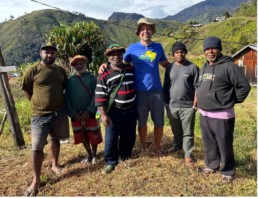
Field partner Yappenda primarily works with the Yali in the highland village of Holuwon.
Holuwon, a village of around 400 people, is primarily inhabited by the Yali ethnic group. Nestled at an altitude of approximately 1,000meters, it is located at the confluence of the Baliem and Heluk rivers, about 70 km southeast of Wamena, the district capital. The Yali residents of Holuwon engage in subsistence farming, with sweet potatoes being their main crop. However, they also cultivate a variety of other crops such as groundnuts, yams, sugarcane, bananas, and cassava in mixed gardens.
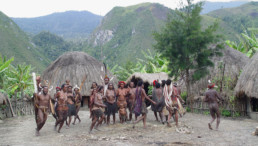
Traditional Yali Ceremony Photo: Ivan Rejon
Unlike the slash-and-burn techniques employed in the surrounding Wamena region, gardening activities in Holuwon do not require such methods. Instead, shrubs and tree branches cleared during initial garden preparation are burned in piles, creating small areas of enhanced fertility. Hunting and gathering activities often occur in or near the cultivation zone, primarily in areas of forest regrowth, contributing to the human modification of the territory.

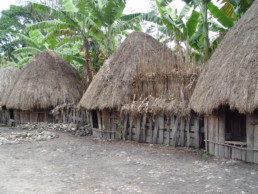
Photo: Ivan Rejon
As communication methods have advanced, the village’s interactions with Wamena, the largest neighboring town in the Baliem Valley, have evolved. This has influenced village livelihoods, with residents frequently sending vegetables, groundnuts, and pigs to the town. In return, they purchase goods from the market, and many of their children pursue higher education in Wamena, given that Holuwon has only a small primary school, which is also supported by Yappenda.
A long time ago, the sky ( bohol) and the earth ( kwenang) were mixed together. The first human beings coming out of the ground at Walma, in Angguruk region, were a man, Ahun Alpa (man of the beginning) and a woman Ohwe unuk Megen (woman of the earth- quake). They separated the sky from the earth, an earthquake happened and Dohlu the pig arrived, together with Dabe the porcupine and Siluwak the snake. Megen and Alpa decided to kill Dabe and Dohlu and extracted from their stomach two long black stones named Yeli asingip (or ‘remains of Yeli’). Their son, Dabe enggele, gave pieces of these stones to a man, Um Balim Balungwe (‘first Baliem man’, in Hupla language), and asked him to go West to the Hupla lands. Um Balim Balungwe travelled underground, follow- ing the tail of the big snake Siluwak and arrived at the Ferawe Mountain, near Seinma.

Photo: Ivan Rejon
Dabe Enggele planted one Yeli Asingip in the ground, tied to a stick, to prevent more humans from coming out of the ground, built a house and opened a garden ( yabuk) with his wife Yeli Milen (‘Thunder of Yeli’). But as the earth still shook because of the snake, they decided to move to a place named Asin, where the head of Siluwak came out in a red lake ( Mep Ahei). On the next morning, after Megen and Alpa came back to Walma, to take care of the original hole in the ground, Siluwak’s head came out of the lake and ordered Dabe Enggele to make a strap bag ( sum) and to fill it in with leaves of several plants. Every night, Siluwak hid inside the strap bag and became biggalem, the moon. Every morning, he came out of the bag and became the sun, mo.
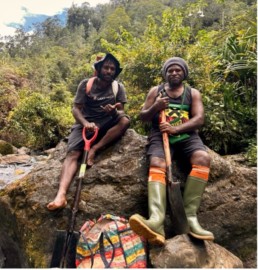
In Walma, Dohlu, the pig, and Dabe, the porcupine, were not yet dead. Dohlu ran away to Asin, where Dabe Enggele captured him, again opened his stomach and again got two Yeli Asingip, one for each moiety. He built a house, using the blood of the pig and leaves from the forest. Inside the house, four posts surrounded the central fire. The two posts ( fisingge) situated far from the main entrance hosted the Yeli Asingip in their hole, and represented each moiety: one for the male part of the house and one for the female. Dabe Enggele implemented the first ritual to stabilise the earth around the village and by this act, he became the first shaman, or hwalahun. As Dohlu managed to escape, Dabe Enggele’s children, two men and a woman, ran after him. They captured him before he escaped again. One night, in the mens’ dream, Dohlu explained to them how to make a ritual house, or ousayowa.
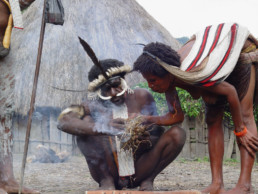
Photo: Ivan Rejon
Each new generation of Yali settled in a new place, while pur- suing Dohlu, started a garden and planted seeds brought from their parents’ village. They made a house and the next generation again pursued Dohlu. The places where the Yali settled, after Asin, were Seila and Wanim Alo. For each place, they extracted sacred stones from Dohlu, a pond appeared, and they started a garden. After many episodes, with Dohlu or Dabe to help and initiate them, they arrived in a place called Puplin, where no pond appeared, and they realised that they were at the end of the Yali territory, and at the beginning of a new territory, with different traditions. They couldn’t find the Yeli Asingip in Puplin, but they found many nearby, under a tree named Selem ( Lithocarpus lauter- bachii , Fagaceae). The traditions were different, so was the way to get the sacred stones. The new settlers mixed with the people from Hosahaikma, a village very close to Holu- won. In the meantime, Dohlu, who was in Walma, entered a pond, travelled under- ground and reappeared near the Prawe mountain, at Seinma.
